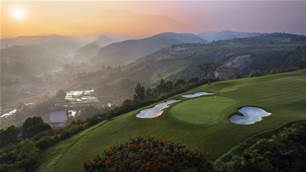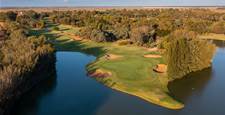Byron Bay is renowned for its natural beauty and laid-back vibe, both of which you will find at its Top-100 ranked golf course.
Ask anyone about Byron Bay on the north coast of New South Wales and they are likely to recall the beautiful surf beaches, relaxed atmosphere or even the famous live music scene. Ask an observant golfer, however, and they are just as likely to first make mention of the town’s scenic golf course.
Located five kilometres south of Byron’s main street, the Byron Bay Golf Club celebrated its 60th anniversary this year, having been conceptualised in 1957 with the current front nine opening the following year.
The conditioning of the par-72 is among the many reasons golfers speak so highly of the layout and regularly return. My recent visit to Byron Bay came after consistent heavy downpours that were barely noticeable once I stepped foot on the 10th tee to start my round. I had to question whether there had been any rain at all when my approach into the hardest hole on the course bounced and released over the back of the green. It was something I had to get used to as all the putting surfaces at Byron Bay are firm and beautifully presented. The true rolling, quality greens are a feature of a game at Byron and are almost without a blemish, thanks in part to their firmness.
It should come as no surprise that a course maintained under the watchful eye of 2014 AGCSA Excellence in Golf Course Management Award winner Shaun Cross is always impeccably presented.
Cross, who head professional Greg Stewart describes as “the most important person at the golf club”, and his small, hardworking team are in the final stages of a turf program that has seen the majority of fairways and some tees converted from Blue couch in favour of the hardier Wintergreen couch, which offers year round quality and consistency. At the time of writing there was only a handful of holes remaining to be converted.
The layout itself is a tale of two nines. The majority of the back nine, which opened in 1983, doesn’t have the dramatic elevation changes to be found on the front nine. But it doesn’t lack interesting and challenging holes that can easily derail your round on the way to the clubhouse. Or cause big numbers early if you play the course back-to-front like I did and the PGA Legends Tour do when playing their year ending Tour Championship here each December.
In addition to the winding 10th hole, which requires an exacting tee shot to avoid the water straight ahead and the practice fairway to the right, the short par-3 14th is among my favourite back nine holes.
Measuring 155 metres from the tips, clever bunkering makes the 14th green appear smaller than its actual size. Tall trees surround the tee making it difficult to judge the almost constant coastal breeze. Water and out-of-bounds come into play on this one-shotter and, despite only holding a short to mid-iron on the tee, walking away with a par is always a satisfying result.
The 16th, the longest of Byron’s par-4s at 399 metres, is another of the standouts for mine. Made to be more of a challenge since my first visit thanks to a large pond on the right side of the tough dogleg left. If you’re lucky enough to find the fairway with the preferred right-to-left tee shot, the test is far from over as judging your approach to the green, perched high above you, always proves difficult.
It is the original front nine at Byron Bay that offers the most memorable holes. The founding members, with some who doubled as course designers, wasted no time in putting their best foot forward with the stretch of holes from the 1st to the 4th.
The par-4 1st hole does as all good opening holes should, giving the golfer an introduction as to what to expect throughout the rest of the course. The lack of fairway bunkering on the opening hole is consistent throughout the majority of the course and the raised green is like many others at Byron, set at a different height to the fairway, making distance control and judgement crucial.
One of three hard dogleg left par-4s on the course, the uphill 347-metre 2nd hole, asks plenty from the tee. A right-to-left tee shot with the driver is ideal here, leaving a short approach into the green. But with houses to the left and a rare fairway bunker on the outside of the dogleg to the right, a fairway wood or iron is a safer play. Once you have managed to find the fairway the second shot is again played uphill to a visually awkward and surprisingly sloping
green that breaks more than the majority of
Byron’s greens.
The first of the par-3s on the traditional routing comes next. Played downhill, the 3rd plays slightly shorter than the 152 metres listed on the card, but is not to be treated lightly. Failing to find the correct portion of the green can lead to long par saving putts and the bunkers and mounding surrounding the green are potential score destroyers, with a short miss far more palatable than long.
Completing the memorable opening sequence is the par-5 4th, the signature hole at Byron Bay. Taking on the challenge from the back tees is worth it, if only to experience the breathtaking view that extends all the way to the ocean over the top of the trees that line the fairway.
A quality tee shot is required on the 538-metre hole that plays downhill and is only reachable for the strongest of players with a rare favourable wind at their back. Placement of your second shot is the all-important play on this hole, as the third shot to the large green is fraught with danger. Water left and right combines with three bunkers to almost completely surround the green, which contains three distinct sections that require a precise wedge approach as simply finding the green regularly results in more than two putts.
The clubhouse sits directly above the stunning 4th green and can be seen from much of the course. Uphill finishes to both nines make the recently renovated clubhouse a sanctuary on a hot summer’s day after negotiating the incline, with the feeling enhanced when grabbing a vantage point on the club’s sprawling deck.
THE COURSE
LOCATION: 62 Broken Head Road, Byron Bay, NSW, 2481.
CONTACT: (02) 6685 6470.
 WEBSITE: www.byronbaygolfclub.com.au
WEBSITE: www.byronbaygolfclub.com.au
OPENED: 1958
SLOPE RAITINGS: 137 (Black men’s tees), 136 (White men’s tees), 133 (Red women’s tees).
PLAYING SURFACES: Wintergreen couch (tees and fairways), 328 couch (greens).
COURSE SUPERINTENDENT: Shaun Cross.
PGA PROFESSIONAL: Greg Stewart.
GREEN FEES: $49 (18 holes); $29 (9 holes); $10 (Junior).
THE CLUB
MEMBERSHIPS: Byron Bay Golf Club offers a variety of extremely affordable membership options based on age and offer a monthly direct debit payment option.
Full membership is $970 for the membership year which runs October to September and includes unlimited social golf and no joining fee. For golfers aged 26-30 the fee is halved to $485, while 18-25 year olds pay $300 and players aged 15-18 just $100. Discounts also apply for those over 80 years of age.
The club offer special membership deals with four new members joining for the price of three and a child of a new member joining free with their mother or father among them.
RECIPROCAL: Northern Rivers District Golf members receive a discounted green fee of $15 plus the appropriate competition fees when playing competitions at Byron Bay Golf Club and also qualify for the ‘local’s rate’ when playing social golf.
Related Articles

International Spotlight: Omanu Golf Club

Course Review: Cape Kidnappers











